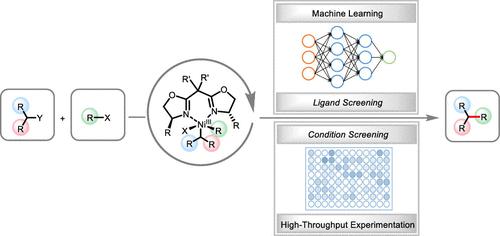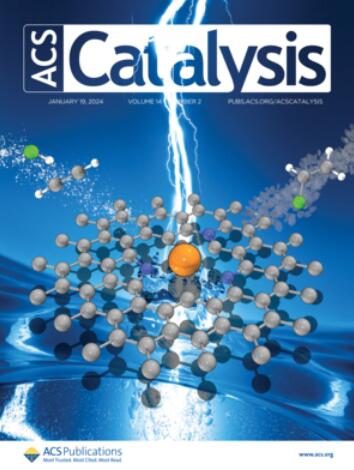Artificial Intelligence-Driven Development of Nickel-Catalyzed Enantioselective Cross-Coupling Reactions
IF 11.3
1区 化学
Q1 CHEMISTRY, PHYSICAL
引用次数: 0
Abstract
The conventional approach to developing asymmetric synthetic methods relies heavily on empirical optimization. However, the integration of artificial intelligence (AI) and high-throughput experimentation (HTE) technology presents a paradigm shift with immense potential to revolutionize the discovery and optimization of asymmetric reactions. In this study, we present an efficient workflow for the development of a series of nickel-catalyzed asymmetric cross-coupling reactions, leveraging AI and HTE technology. Many nickel-catalyzed enantioselective cross-coupling reactions share a common Ni(III) intermediate, which dictates the enantioselectivity. To harness this mechanistic insight, we embarked on developing a predictive model for nickel-catalyzed enantioselective coupling reactions, elucidating the general rules governing enantioselectivity. Through the application of data science tools and HTE technology, we curated a data set to construct an AI-based model. This model was subsequently utilized to facilitate the discovery of efficient nickel hydride-catalyzed enantioselective and regioselective cross-coupling reactions. Employing AI-assisted virtual ligand screening and HTE-enabled condition optimization, we successfully identified optimal ligands for eight coupling reactions. Consequently, a series of chiral sp3 C–C bonds were synthesized with high yield and enantioselectivity.

人工智能驱动下镍催化对映选择性交叉偶联反应的发展
开发不对称合成方法的传统方法在很大程度上依赖于经验优化。然而,人工智能(AI)和高通量实验(HTE)技术的集成呈现出一种范式转变,具有巨大的潜力,可以彻底改变不对称反应的发现和优化。在这项研究中,我们提出了一个高效的工作流程,用于开发一系列镍催化的不对称交叉偶联反应,利用人工智能和HTE技术。许多镍催化的对映选择性交叉偶联反应都有一个共同的Ni(III)中间体,这决定了对映选择性。为了利用这种机制的洞察力,我们着手开发镍催化的对映选择性偶联反应的预测模型,阐明控制对映选择性的一般规则。通过应用数据科学工具和HTE技术,我们整理了一个数据集来构建一个基于人工智能的模型。该模型随后被用于促进氢化镍催化的高效对映选择性和区域选择性交叉偶联反应的发现。通过人工智能辅助的虚拟配体筛选和hte条件优化,我们成功地确定了8种偶联反应的最佳配体。从而合成了一系列具有高收率和对映选择性的手性sp3 C-C键。
本文章由计算机程序翻译,如有差异,请以英文原文为准。
求助全文
约1分钟内获得全文
求助全文
来源期刊

ACS Catalysis
CHEMISTRY, PHYSICAL-
CiteScore
20.80
自引率
6.20%
发文量
1253
审稿时长
1.5 months
期刊介绍:
ACS Catalysis is an esteemed journal that publishes original research in the fields of heterogeneous catalysis, molecular catalysis, and biocatalysis. It offers broad coverage across diverse areas such as life sciences, organometallics and synthesis, photochemistry and electrochemistry, drug discovery and synthesis, materials science, environmental protection, polymer discovery and synthesis, and energy and fuels.
The scope of the journal is to showcase innovative work in various aspects of catalysis. This includes new reactions and novel synthetic approaches utilizing known catalysts, the discovery or modification of new catalysts, elucidation of catalytic mechanisms through cutting-edge investigations, practical enhancements of existing processes, as well as conceptual advances in the field. Contributions to ACS Catalysis can encompass both experimental and theoretical research focused on catalytic molecules, macromolecules, and materials that exhibit catalytic turnover.
 求助内容:
求助内容: 应助结果提醒方式:
应助结果提醒方式:


